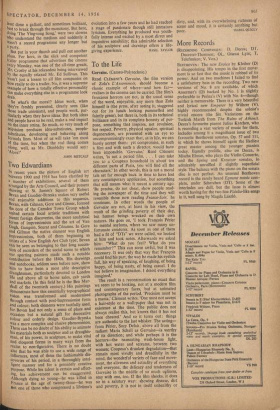To the Life
Gervaise. (Cameo-Polytechnic.)
Red CUMENT'S Gervaise, the film version of Zola's L'Assommoir, should become a classic example of where—and how far— realism in the cinema can be carried. The film's ferocious horrors are not, in the usual sense of the word, enjoyable, any more than Zola himself is (the press, after seeing it, staggered out for its lunch looking pummelled and faintly green), but there is, both in its technical brilliance and in its complete honesty of pur- pose, something that inspires, not revulsion, but respect. Poverty, physical squalor, spiritual degeneration, are presented with an eye so uncompromisingly exact that, ag in life, we can barely accept them : yet compromise, in such a film and with such a director, would have been impossible. 'Gervaise,' Rend Clement writes, 'is not a period film. . . . I can take you to a Coupeau household in about ten different parts of Paris, you will find all the characters.' In other words, this is not a moral talc set far enough back in time to have lost any contemporary application, but something that still means what it meant a century ago. 'Be precise, do not cheat, show people read- ing the newspaper of the time and they will resemble those now reading France-Soir,' he continues. In other words the people of Gervaise are not, at least in his view, the result of the grinding poverty of their day, but human beings wrecked on their own natures. He goes on, 'I took Francois Perier to mental asylums, where we saw many un- fortunate creatures. As soon as one of them had a fit of "DTs" we were called, we looked at him and took notes. Afterwards we asked him : "What do you feel? What do you remember?" This can seem awful, but it was necessary. It was only that way that Francois could find his part, the way he made his eyelids fall, his way of speaking, of laughing, of being happy, of being nasty, of being casual. I do not believe in imagination. I detest everything imagined.'
The result is a reconstruction so exact that we seem to be looking, not at a modern film and contemporary faces, but at animated photographs of the period. 'Precision must be a mania,' Clement writes. 'One must not accept a hair-style or a wall-paper that was not in existence at the time. The public does not always realise this, but knows that it has not been cheated.' And so it turns out : things are authentic to the last whisker. The acting— from Paler, Suzy Delair, above all from the radiant Maria Schell as Gervaise—is worthy of its direction; and while perhaps it is the horrors—the nauseating wash-house fight, with hot water and screams, between two women; Coupeau's drunken degradation—that remain most vividly and dreadfully in the mind, the wonderful variety of face and move- ment, the aliveness and actuality of everything and everyone, the delicacy and tenderness of Gervaise in the middle of so much ugliness, stay with one, too. If the film shocks, it does so in a salutary way: showing disease, dirt and poverty, it is not in itself unhealthy or dirty, and, with its overwhelming richness of scene and mood, it is certainly anything but










































 Previous page
Previous page